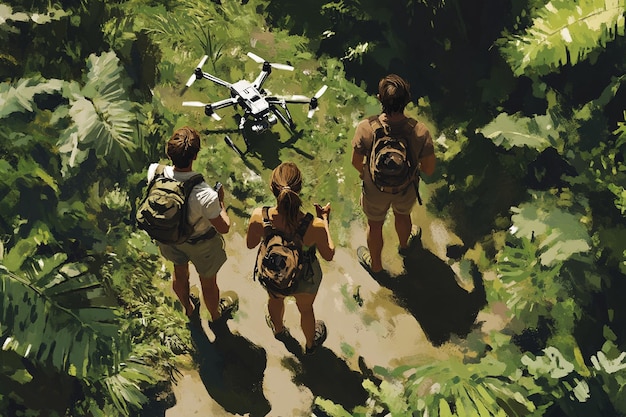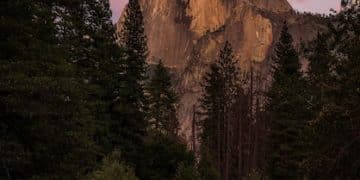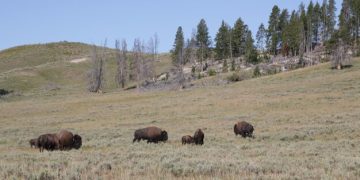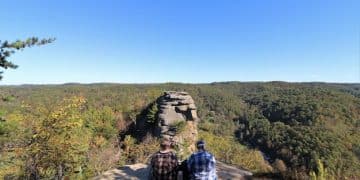New Initiatives for Endangered Species Preservation in National Parks

New initiatives for preserving endangered species in national parks include habitat restoration, combating poaching, implementing scientific monitoring, and promoting public awareness and engagement.
Ensuring the survival of endangered species within national parks requires continuous innovation and dedicated effort. Discover what are the new initiatives for preserving endangered species in national parks that are making a significant impact on biodiversity and ecosystem health.
Understanding Endangered Species in National Parks
National parks serve as critical refuges for a vast array of plant and animal species. However, many of these species face the threat of endangerment due to various factors, including habitat loss, climate change, and human activities. Understanding the challenges these species face is crucial for developing effective conservation strategies.
Endangered species play a vital role in maintaining the ecological balance within national parks. Their decline can trigger a cascade of negative impacts on the entire ecosystem, affecting everything from pollination to nutrient cycling. Recognizing the importance of these species underscores the need for proactive measures.
The Role of National Parks in Conservation
National parks provide protected habitats where endangered species can thrive with minimal human interference. These parks often encompass diverse ecosystems, offering a range of environments suitable for different species. By safeguarding these areas, national parks contribute significantly to global biodiversity conservation.
Threats to Endangered Species
Despite the protection afforded by national parks, endangered species still face numerous threats. Habitat destruction, often resulting from logging, mining, and infrastructure development, remains a primary concern. Climate change exacerbates these challenges by altering habitats and disrupting natural processes. Poaching, illegal wildlife trade, and invasive species further compound the difficulties faced by endangered species.

Effective conservation requires a comprehensive approach that addresses these diverse threats while fostering collaboration between park authorities, scientists, and local communities. It’s essential to implement strategies that protect and restore habitats, mitigate the impacts of climate change, and combat illegal activities that harm endangered species.
In the following sections, we will delve into the innovative initiatives currently underway in national parks to preserve these vulnerable species and ensure the health and resilience of our natural heritage. By understanding these efforts, we can better appreciate the dedication and resources needed to safeguard endangered species for future generations.
- Habitat Loss: Deforestation and development reduce suitable habitats.
- Climate Change: Shifts in temperature and weather patterns alter ecosystems.
- Poaching: Illegal hunting and trade decimate species populations.
- Invasive Species: Non-native species outcompete native ones for resources.
In conclusion, understanding the multifaceted threats faced by endangered species within national parks emphasizes the urgent need for comprehensive and innovative conservation strategies. By addressing habitat loss, climate change, poaching, and invasive species, we can better protect these vulnerable populations and preserve the ecological integrity of our natural landscapes.
Habitat Restoration and Management Programs
Habitat restoration and management programs are vital for creating and maintaining suitable environments for endangered species within national parks. These initiatives aim to rehabilitate degraded habitats, control invasive species, and promote the growth of native flora, all of which contribute to the survival and recovery of threatened populations.
Restoring habitats often involves removing invasive plants, reintroducing native species, and improving water management. These efforts not only benefit endangered species but also enhance the overall health and resilience of the ecosystem.
Active Habitat Restoration
Active habitat restoration involves directly intervening to repair damaged ecosystems. For example, in areas affected by deforestation, park authorities may plant native trees and shrubs to restore the forest canopy. Similarly, wetlands may be restored by removing drainage structures and reestablishing natural water flows.
Invasive Species Control
Invasive species can outcompete native flora and fauna, disrupting the balance of ecosystems. Control programs often involve manual removal, chemical treatments, and biological control methods. These measures help to reduce the abundance of invasive species and allow native populations to recover and thrive.
- Native Plant Reintroduction: Planting native species to restore ecosystems.
- Water Management: Improving water flows to support wetland habitats.
- Erosion Control: Implementing measures to prevent soil erosion.
- Soil Remediation: Restoring soil health through various techniques.
By implementing these comprehensive habitat restoration and management programs, national parks are actively working to create environments where endangered species can thrive. These initiatives not only address existing threats but also enhance the overall health and resilience of the ecosystem, ensuring its long-term sustainability.
Combating Poaching and Illegal Wildlife Trade
Combating poaching and the illegal wildlife trade is a critical aspect of protecting endangered species in national parks. These activities pose a severe threat to vulnerable populations, often driving species closer to extinction. Enhanced anti-poaching patrols, technological advancements, and international collaborations are essential components of this effort.
Addressing the root causes of poaching, such as poverty and lack of awareness, requires a multi-faceted approach that involves local communities and promotes sustainable livelihood options. Effective law enforcement and stringent penalties serve as deterrents, while educational programs foster a sense of stewardship among the public.
Enhanced Anti-Poaching Measures
National parks are deploying enhanced anti-poaching measures to protect endangered species from illegal hunting. These measures include increased ranger patrols, improved surveillance technology, and rapid response teams. By strengthening law enforcement efforts, parks can deter poachers and disrupt wildlife trafficking networks.
Use of Technology
Technological advancements play a crucial role in combating poaching. Drones equipped with thermal imaging cameras can detect poachers in remote areas, while GPS tracking devices help monitor the movements of endangered animals. These tools enable park authorities to respond quickly to threats and gather valuable data for conservation planning.

Through the integration of technology and traditional law enforcement practices, national parks are better equipped to protect endangered species from poaching and illegal wildlife trade. These efforts not only safeguard vulnerable populations but also contribute to the overall health and resilience of the ecosystem.
- Ranger Patrols: Increased patrols to monitor and protect wildlife.
- Drone Surveillance: Using drones for aerial surveillance.
- GPS Tracking: Monitoring animal movements to prevent poaching.
- Community Engagement: Involving local communities in conservation efforts.
By intensifying anti-poaching measures and leveraging technological advancements, national parks are working diligently to safeguard endangered species from illegal hunting and trade. These initiatives play a pivotal role in preserving vulnerable populations and maintaining the ecological integrity of our natural landscapes.
Scientific Monitoring and Research Programs
Scientific monitoring and research programs are integral to understanding the dynamics of endangered species populations and their habitats within national parks. These programs provide valuable data on population trends, habitat use, and the impacts of environmental changes, informing adaptive management strategies and conservation planning.
Long-term monitoring efforts enable park authorities to track the effectiveness of conservation measures and adjust their approaches as needed. Collaborative research projects involving universities, government agencies, and non-profit organizations enhance the scientific basis for decision-making.
Population Monitoring
Population monitoring involves tracking the size, structure, and distribution of endangered species populations. Techniques such as camera trapping, radio telemetry, and mark-recapture studies are used to gather data on individual animals. This information helps park authorities assess the health and viability of populations and identify factors limiting their growth.
Habitat Assessments
Habitat assessments evaluate the quality and availability of habitat for endangered species. These assessments involve measuring vegetation cover, water availability, soil composition, and other environmental factors. By understanding habitat characteristics, park authorities can identify critical areas for conservation and prioritize restoration efforts.
- Camera Trapping: Using cameras to monitor wildlife populations.
- Radio Telemetry: Tracking animal movements with radio collars.
- Genetic Studies: Analyzing genetic diversity within populations.
- Habitat Mapping: Creating detailed maps of habitat types and their condition.
By integrating scientific data into conservation planning, national parks can make informed decisions that promote the long-term survival of endangered species and the health of their ecosystems. These programs underscore the importance of evidence-based conservation and adaptive management in the face of ongoing environmental changes.
Public Awareness and Engagement Initiatives
Public awareness and engagement initiatives are essential for fostering a sense of stewardship and support for endangered species conservation in national parks. These programs aim to educate the public about the importance of biodiversity, the threats facing endangered species, and the actions they can take to help protect them. Engaging local communities and visitors alike in conservation efforts strengthens the connection between people and nature, promoting sustainable practices and responsible behavior.
Interpretive programs, educational materials, and volunteer opportunities provide avenues for people to learn about and contribute to conservation. By raising awareness and inspiring action, national parks can cultivate a culture of conservation that extends beyond park boundaries.
Interpretive Programs
Interpretive programs offer visitors opportunities to learn about endangered species and their habitats through guided tours, exhibits, and educational presentations. These programs help to connect people with the natural world and deepen their understanding of conservation issues. Engaging interpreters provide insights into the ecological significance of endangered species and the challenges they face.
Educational Materials
Educational materials, such as brochures, websites, and social media campaigns, disseminate information about endangered species and conservation efforts to a broad audience. These materials provide valuable resources for learning about the importance of biodiversity and the actions individuals can take to support conservation. By reaching people through multiple channels, national parks can amplify their conservation message and inspire action.
- Guided Tours: Educating visitors about local wildlife and habitats.
- Exhibits and Displays: Showcasing conservation efforts and endangered species.
- Social Media Campaigns: Raising awareness through online platforms.
- Volunteer Programs: Engaging the public in hands-on conservation activities.
Through these public awareness and engagement initiatives, national parks build strong relationships with local communities and visitors, fostering a shared commitment to protecting endangered species. By empowering people with knowledge and opportunities for action, these programs create a lasting impact on conservation.
Policy and Regulatory Frameworks
Effective policy and regulatory frameworks are essential for guiding and enforcing conservation efforts for endangered species within national parks. These frameworks provide the legal basis for protecting habitats, regulating human activities, and implementing conservation measures. Compliance with these policies is crucial for ensuring the success of conservation efforts and preventing further decline of endangered species populations.
Adaptive policies that respond to changing environmental conditions and scientific knowledge help to maintain the effectiveness of conservation measures. Collaboration between government agencies, non-profit organizations, and local communities strengthens the enforcement and implementation of conservation policies.
The Endangered Species Act (ESA)
The Endangered Species Act (ESA) is a cornerstone of conservation policy in the United States, providing legal protection to listed species and their critical habitats. The ESA prohibits the take of endangered species and requires federal agencies to consult with the U.S. Fish and Wildlife Service or the National Marine Fisheries Service to ensure that their actions do not jeopardize listed species or their habitats.
Park-Specific Regulations
In addition to federal laws, national parks often have park-specific regulations that address local conservation needs. These regulations may include restrictions on development, limitations on visitor activities, and requirements for environmental impact assessments. By tailoring regulations to local conditions, national parks can better protect endangered species and their habitats.
- Habitat Protection: Regulations safeguarding critical habitats.
- Activity Restrictions: Limiting human activities to minimize disturbance.
- Enforcement Measures: Penalties for violations of conservation laws.
- Adaptive Management: Adjusting policies based on new scientific information.
By establishing clear and enforceable policies, national parks provide a framework for protecting endangered species and their habitats. These frameworks ensure that conservation efforts are consistent, effective, and responsive to the needs of both the species and the ecosystems they inhabit. The ongoing assessment and adaptation of these policies are vital for preserving endangered species in a changing world.
| Key Point | Brief Description |
|---|---|
| 🌱 Habitat Restoration | Restoring degraded habitats to support endangered species. |
| 🛡️ Combating Poaching | Enhancing anti-poaching measures and using technology. |
| 🔬 Scientific Monitoring | Tracking population trends and habitat quality through research. |
| 📣 Public Awareness | Educating the public and engaging communities in conservation. |
Frequently Asked Questions (FAQ)
▼
An endangered species is a plant or animal that is at risk of extinction. These species often have small populations or face significant threats such as habitat loss, poaching, or climate change, making their survival precarious.
▼
Endangered species play critical roles in their ecosystems. Their loss can disrupt food chains, reduce genetic diversity, and destabilize ecological processes. Protecting them helps maintain healthy and resilient ecosystems essential for all life.
▼
National parks implement various strategies, including habitat restoration, anti-poaching patrols, scientific monitoring, and public education programs. These efforts aim to protect and recover endangered species within park boundaries.
▼
The public can support conservation efforts by visiting national parks responsibly, donating to conservation organizations, advocating for protective policies, and educating others about the importance of biodiversity. Every action counts!
▼
You can learn more by visiting the websites of national parks, conservation organizations, and government agencies dedicated to wildlife protection. Many offer resources, educational materials, and volunteer opportunities for further engagement.
Conclusion
In conclusion, the ongoing initiatives for preserving endangered species in national parks represent a comprehensive and adaptive approach to conservation. Through habitat restoration, anti-poaching measures, scientific monitoring, public engagement, and effective policies, national parks are working to safeguard vulnerable species and the ecological integrity of our natural heritage. The continued success of these efforts requires collaboration, innovation, and a shared commitment to protecting biodiversity for future generations.





